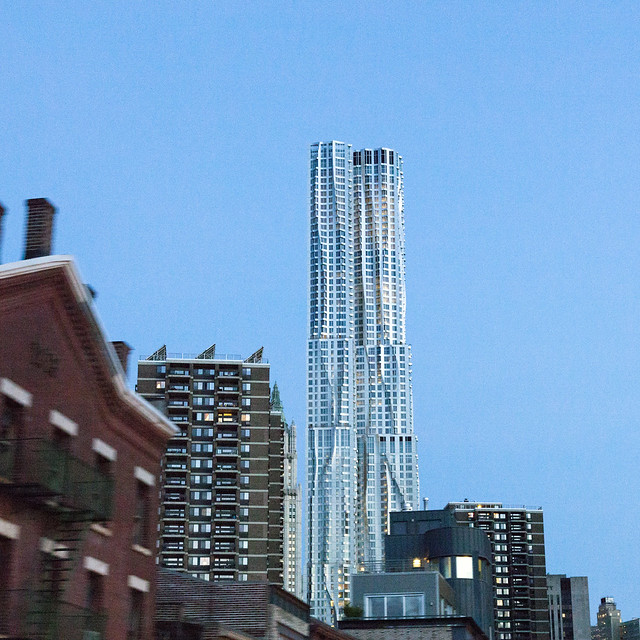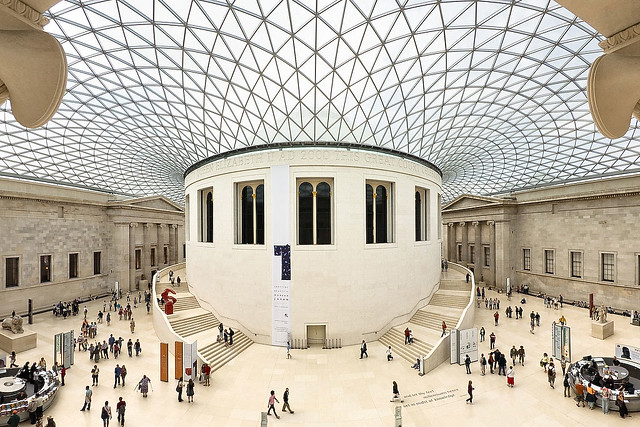It might seem to be all Eisenhower Memorial all the time around here, but stick with us. If you are just joining us, here is the nickel version: Frank Gehry was selected from a short list of pre-qualified firms to design a memorial in Washington D.C. to President Eisenhower. His design has been met with a vocal minority of critics, which I covered in On the Eisenhower Memorial Critics. The criticism hasn’t fallen on deaf ears, as just yesterday a revised Eisenhower Memorial design was unveiled.

A conversation with a Gehry critic
I have been corresponding for the last few days with a reader and critic of the design, a reader who I believe to be connected with the National Civic Art Society, one of the leading groups against the memorial. I want to thank Reader M for the conversation, which could have gone off the rails into yellingtown easily. Below is a roundup of Reader M’s conversation:
Perhaps those who oppose the Gehry Memorial oppose the memorial for sound aesthetic, contextual, and factual reasons. Please understand that those who oppose the memorial are not insane fanatics who intend to destroy you. Our built environment needs sound criticism. I would hope that in the future you consider your written opinions seriously, deeply, and fairly.
…Architecture is not a calling. The practice of architecture is an art, a craft, a job. Architecture is the structures made for human use. Good architecture serves humanity well. Great architecture improves humanity. Gehry’s memorial is not great architecture, it is not good architecture, it is not good art, it is probably poor craft, but it is an important job. Gehry has made fine buildings. His design for the Eisenhower Memorial is not among his fine buildings.
…Why should the monument not be built? Because Gehry’s Eisenhower Memorial design insults the president, the general, the man. Gehry’s insult in this building is similar to the insult Gehry forcefully makes to those who have suffered brain injuries in his Lou Ruvo Center for Brain Injuries building. If you are unfamiliar with this building, find a picture and you will see the implicit sadistic insult of its form. The insult to Eisenhower is not so much in its inarticulate form as in its bluntly stupid misinterpretation of the heroes’ role in the life of a nation’s citizens. Perhaps Gehry makes this error because he is not a hero, perhaps because he is anti-heroic, perhaps because he is dimwitted. Having seen Gehry on video-tape, he is, in my opinion, the only star in his universe: yes, he is dimwitted because he is incapable of sympathy. The man understands in stereotype, unsubtly.
I speak here, generally, of both the former, failed design, and of the current improved, failed design. Ask yourself: Could a freshman, basic design class from a typical 1970’s art school have produced either design. If you are honest, you must say that, “Yes, Gehry’s Eisenhower Memorial design is no better and no worse than the typical, awkward freshman art project.” His design is celebrated because he is thought to be a great architect, because experts agree that he is a great architect, because he is just now in fashion for all the foolish pretexts. If you cannot see with your mind’s eye, I cannot help you. Yet, I suspect that you can see Gehry’s typical failure in that that room full of typical failures, and seeing can understand my point. Dwight David Eisenhower deserves better.
…Oh, yes: The insult. Eisenhower is not insulted because he was a boy, you too were a boy, many of us were boys and did this-and-that in the way of boys, almost none of what we did being worthy of comment. Kansas’ Senator Roberts is pleased that Kansas is represented in the memorial, as he would be pleased with a billboard of Kansas on I-395, but neither Kansas nor boyhood is essential to that internal presence–shall we say soul, the Spirit of God, our aspiring humanity, surely we will not imagine a nonexistent id or ego–that imposed itself upon the world. Well, if not that indescribable internal thing then the body, for certainly the man had a body, as we all have bodies, yet bodied we do not all achieve excellence, so the body alone is not the thing, nor is boyhood, nor is Kansas. What then is the meaning of the man? A few cherry picked quotes advancing a leftist theme? It was honey in my cup to read the Gehry team misspelling “Farwell Address” [Farewell Address] in the too often referenced military-industrial complex paragraph. As you know, bodies are not the manifestation of photographs, as modernists seem to believe, and Modernists seem almost incapable of creating statuary that has not been derived from photographs: This is as though the proof of existence is the superficies of things, not the essence of things.
What in this monument insults Eisenhower, other than that he would not approve the style, the physical magnitude, and the diminutive concept? Eisenhower is insulted because he was not a body doing things here-and-there, saying this-and-that, too large and too small, haphazardly from part to part, confused, awkward, reduced to a not-quite-clever design project. Do you suppose that Eisenhower standing in front of this monument would recognize himself, other than in the accuracy of his manikin image? Would he be proud, humbled, embarrassed? I could go on, but the theme is so obvious that it is a bore. For all the mods’ high-falut’n rhetoric of meaning abstracted, mods seem incapable of manipulating form to create meaning. Inarticulate, the mods can destroy, can distort, can disembody, but they cannot create that internal spirit which is universal in classical form and idea. Let Gehry make twisted planes to amuse children and the child-like culture, let him flatter know-it-alls, and let him tickle social climbers, but please, do not let him fumble the precious gem of our nation’s honor.
This new model contains all the old, twisted cyclone fence bird and trash trap, but is not shown. Support it, if you like. Call we who oppose it conservatives, anti-revolutionaries, rotten nuns who would take away your candy and slap your knuckles with rulers, but give us credit with keeping the house in order…
Typologies of criticism
From my correspondence with Reader M, and reading other critics of this project, the overall criticism seems to fall into four categories:
- Eisenhower’s family opposes it, so it shouldn’t be built
- Frank Gehry is a bad person
- Gehry’s past work is horrible
- The memorial design itself is bad
The first is laughable – if the Eisenhower family wants to build a memorial on their land, be my guest. They don’t get a veto when public land is being used and the federal government is sponsoring the memorial. They are free to voice their opinions, but their opinions are weighed with other professional, and lay, criticism.
The second group of criticism is anchored around Frank Gehry’s past writings, and himself personally. There appears to be a new (as in last 5-10 years old) pattern of vilifying publicly famous architects, such as Frank Gehry, in a manner which politicians and public officials would find familiar. Changing names and subject, the accusations lobbed at Gehry – he is dimwitted, without sympathy and he willfully insults brain patients – could all be 30 second political commercials. This type of criticism, that an architect has malice against brain patients especially, is unneeded. Also unneeded is accusing architects of designing Nazi concentration camp fences – Susan Eisenhower accused Gehry of this (really) – when disagreeing with a design decision. The ridiculous Truth about the Eisenhower Memorial (as if the truth was being concealed) website has pages and pages of quotes from Gehry, taken out of context, proving he is a bad man. Most quotes focus on Gehry’s observation that contemporary life is, chaotic, dangerous, and surprising. Buildings should reflect that.
Critics: personal attacks agains the man, not the idea, weaken your criticism and make you look petty.
I will grant past work informs current and future work, but I ask critics to keep their critique with the memorial itself; use past work as a contextualization of the design at hand.
As for actual criticism of the design itself, often it is vague and ambiguous. Milton Grenfell, vice chairman of the National Civic Art Society, said the new design remained overscale, “with huge iron curtains,” and called the inscribed stones perched atop one another “willful” and “anti-aesthetic,” giving a feeling of “something that’s not going to last.” Is Mr. Grenfell really calling Gehry anti-beauty?
Finally when pressed for specific issues with the current design, critics often rely on the fallacy that the design is so self-evidently and obviously wrong that they don’t need to explain why or how. This is the most frustrating part: just explain why you don’t like it.
Case in point: the mini-controversy about showing Eisenhower as a small child. I still don’t understand why showing Eisenhower throughout his life with three statues – as a boy, a General, and as President – is an issue. From my understanding his humility was a core feature of his life. Eisenhower’s story is uniquely American: a boy from Abilene, Kansas growing up to lead one of the most powerful forces ever assembled, and then putting aside his weapons to lead the nation as a civilian President. That’s a great story, but it is so wrong and beyond the pale that no explanation is required – because it is so wrong.
Across all these categories is a thin layer of perceived persecution and fear that some other is hiding information. The National Civic Art Society’s website is entitled The Truth about the Eisenhower Memorial, as if it was hidden. The whole tone of the website would be familiar to those who have landed on conspiracy websites: webmasters reveal the truth
to their readers which was suppressed by nefarious forces.
Critique of the now
What was interesting about the conversation, is that Reader M kept bringing up Modernism, as if this was all Modernism’s fault. I don’t think the use of the term “mods” – as in Modernism – quite applies to Frank Gehry or many contemporary architects. Certainly Gehry’s peers such as Zaha Hadid, Rem Koolhaas, Peter Eisenman, or Bjarke Ingels would not be called Modernists either. Modernism as a movement hasn’t been relevant in some time. What I hear for these critics is a critique of contemporary modernity, not Modernism, and a desire to return to an architecture which has an “internal spirit which is universal in classical form and idea.”
Well, unless you want to turn the clock back on time (and yesterday wasn’t as great as you think it was), that isn’t going to happen. At best we can look to form a syncretic mix of classical values, ideals and forms, with contemporary realty, need, desire, and technology. Gehry is exploring similar themes, in an albeit repetitive fashion.
I had a professor in college who would draw a dialectic between Peter Eisenman and Frank Lloyd Wright. He would pretend the two architects were arguing in a live debate. In the professor’s words, Eisenman was saying, “You can’t go back. We have to find a new vocabulary of expression to deal with the unique needs of the now.” And on the other side Wright would say, “Oh yes you can go back. Typologies existed since before time: a church has always looked like a church, and a chimney always has looked like a chimney.”
Both architect’s writing is highly polemical, and my guess is that we probably need to borrow from both sides of the dialectic. Maybe Foster’s Great Court of the British Museum (above) or Bjarke Ingels Group’s The Mountan (below) are good examples of this syncretic ideal.
Why obsess about this?
This isn’t a new debate – at some point an Ionic capital sculpter was probably being yelled at by a doric capital sculpter. Besides the infamous 1982 Harvard debate between Peter Eisenman and Christopher Alexander (please, send video!), what I feel has changed is the tenor of the discourse.
I am spending a lot of time thinking about this not because I think the Gehry designed Eisenhower Memorial is a landmark worth fighting for. Rather, I find the current level of discourse distressing and worrisome; we should all care that the critique leveled by professionals and laity lack coherence and actionable criticism. The firehose of vitriol against the man, and the design, gives me pause. Architecture and design has, and is, intertwined with the larger culture and public sphere. If the larger discourse around space, environment and culture continue down this path, then count me out.
Next up, what exactly are my thoughts on the Gehry designed Eisenhower Memorial? Those thoughts coming soon.




3 thoughts on “Reader Response on the Eisenhower Memorial”
Comments are closed.